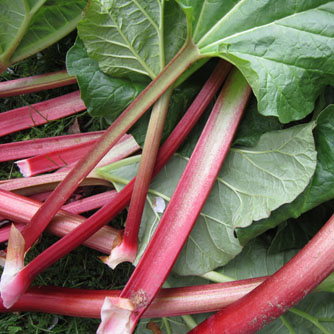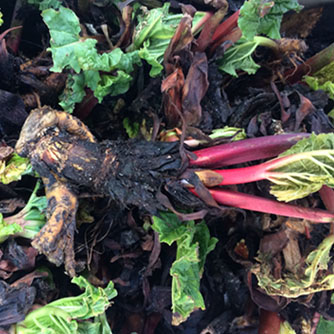Rhubarb
BackRhubarb is a bit of an old fashioned plant that is enjoying a revival as more and more people get into growing their own veggies. It’s red stems have a distinctive tart flavour and are packed full of nutrients such as iron, calcium, potassium and folate. Rhubarb is most commonly used in sauces, crumbles and desserts like rhubarb and apple pie. Yum!
How To Grow Rhubarb
Rhubarb is a cool climate perennial that can be grown as far north as the subtropics. It’s not a plant that copes well with hot humid weather which restricts it being grown any further north. Cold weather tends to produce the best red stems but don’t despair if yours stay green – they are still edible and just as tasty.
Choose a sunny position that has shelter from harsh afternoon sun and is a bit separate from the rest of the veggies as rhubarb doesn’t like much root disturbance. It does love rich fertile soil so be sure to work in lots of compost and manure. Soil should also be free draining so apply gypsum to clay soils before planting. Rhubarb prefers only slightly acid soil and most Aussies soils are too acidic but this can be corrected with some dolomite.
Rhubarb can be grown from either seeds or a division of the plant base called a crown. Crowns are usually available from nurseries or mail order catalogues in autumn and winter. If a friend has a large rhubarb clump you can dig it up and divide the base to create your own crowns. This should be done in autumn or winter. Plant the crowns, water in with an application of OCP eco-seaweed and mulch with some sugarcane mulch.

Established rhubarb plant
If sowing seed this can be done directly into the soil in spring and they’ll take about 10-14 days to germinate. Note that plants grown from seed can be variable and some may not produce strongly coloured red stems.
Rhubarb needs to be kept well watered especially throughout the hot summer months. Allow plants to develop to a decent size before harvesting leaves.
Fertilising and Harvesting Rhubarb
Rhubarb is a heavy feeder so fortnightly applications of OCP eco-seaweed and OCP eco-aminogro is recommended. Top up with some manure and organic pelletised fertiliser each spring to encourage more growth.
When harvesting rhubarb choose the outer leaves first and break them off at the base of the plant so that the whole stalk comes away. Cut off the leaf part, which is poisonous, and discard in the compost. Only the stalks should be eaten.
If any flower heads develop these should be pinched out at the base to promote more leaf growth.

Freshly harvested rhubarb stalks (remember to only eat the stems and discard the leaves)
Pests and Diseases of Rhubarb
Not many things attack rhubarb so as long as the summers aren’t too hot and humid you shouldn’t have many problems:
- Leaf spotting can occur due to various fungal or bacterial infections. Remove badly infected leaves and start watering foliage with the mix OCP eco-seaweed and OCP eco-aminogro. This will encourage plenty of strong new growth which is more resistant to attack. If disease problems persist then spray with an organic fungicide.
- Aphids may attack new growth but can be controlled with a horticultural oil spray.
- Rust can sometimes be a problem but rarely if the OCP eco-seaweed and OCP eco-aminogro mix is being applied.
- Crown rotting may occur if plants are over watered or there is poor drainage. Adjust your watering regime and check soil drainage. Apply gypsum to help break up clay soils.
- Plants which grow poorly and wilt easily could be suffering from parasitic nematodes which are damaging the roots. Dig up a section and if the roots are lumpy and very knotted then treat the soil with OCP eco-nemguard.

Rhubarb crown ready for planting


